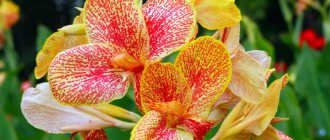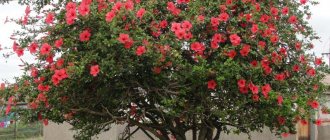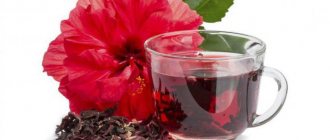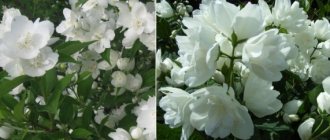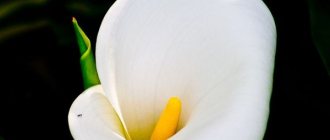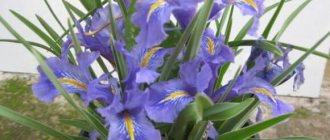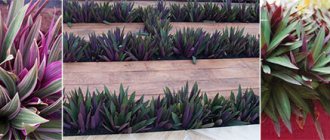Hibiscus is one of the subtropical evergreen plants with spreading branches and delicate rosette-shaped flowers. The second name that has stuck is “Chinese rose”. Many flower growers have known it since the times of the Soviet Union, when beautiful shrubs with delicate scarlet flowers decorated the halls of film clubs, library halls and apartments. However, many facts have been collected around hibiscus, some true and some not so true. We’ll tell you in more detail why it was nicknamed “the flower of death,” how to properly care for this plant when grown indoors, and what benefits hibiscus can bring.
Botanical characteristics of hibiscus
The morphological, physiological and environmental parameters of this plant are represented by the following characteristics:
- Ecological group – perennial (rarely annual, for the herbaceous form) evergreen shrub, a woody form of life is also found;
- Department: Flowering plants;
- Class: Dicotyledons;
- Family: Malvaceae;
- Genus: Hibiscus (Hibiscus);
- Leaves: petiolate, more or less incised with reticulate venation, leaf blade simple;
- Flowers simple or double;
- Fruit: five-leaf capsule with smooth or slightly hairy seeds. Seeds are contained in large quantities.
How to cook properly
In order for the brew to impart the maximum amount of useful substances to the infusion, it is necessary to follow important rules for preparing the drink. There are several different recipes for brewing hibiscus.
- Boiling. Add 2 tbsp to a small saucepan. l. dry petals and pour one glass of boiling water over them. Heat the container with tea leaves over low heat for about 3-5 minutes. When the broth is almost ready, add a little sugar to it. To achieve a more tart, rich taste, increase the heating time to 10 minutes. And do not forget that the longer the raw material is subjected to heat treatment, the less valuable microelements remain in it.
- Hot brewing. In this case, the tea is prepared directly in the mug. 1-2 tsp. pour dried rosella with barely boiling water. You can drink hibiscus brewed in a cup after 5-7 minutes.
- Cold way. Soak the flowers in the cooled liquid for a couple of hours. Then pour the tea leaves into a fireproof container (for example, a saucepan) and place on low heat. Bring the broth to a boil and continue cooking for 3-5 minutes. Strain the prepared drink and add sugar (optional).
The uniqueness of hibiscus also lies in the fact that its steamed petals with sourness can be eaten.
Why is hibiscus called the “flower of death”?
Many beliefs, signs and legends have long gathered around hibiscus. The beauty and large size of the flowers attracted not only lovers of flowering plants, but also warlocks, sorcerers, and witches. This brought only bad, unproven fame. Constant and long-term observations of people over the annual development cycle of the plant have borne fruit: they have established that hibiscus blooms at approximately the same time - from April to September. However, there have also been abnormal cases of flowering. If suddenly a hibiscus suddenly bloomed at an out-of-hours time, according to the generally accepted opinion, unpleasant coincidences would occur: someone would inevitably die during the period of unexpected flower activity.
Since then, it has become common knowledge that this behavior pattern of the Chinese rose serves as a harbinger of serious illness and death. An even worse sign was considered to be the sudden withering and drying of this plant, as they say, out of the blue for no reason. People began to assume that the flower has internal magic, energy vampirism, and sucks the vitality out of weak people. Therefore, if such a flower stood in a house where a person was seriously ill, the plant was superstitiously taken out or rearranged to avoid direct contact of the patient with the “harbinger of death.”
Of course, the plant is not to blame for anything, and all the troubles are just the result of sad circumstances and long-standing superstitions passed down from generation to generation. When thinking about cultivating hibiscus at home or in the garden, do not despair - it will not cause you harm, and the flowering period when grown far from the homeland of this species is not strictly established. There is no need to look for hidden meaning where there really is none. Most often, flowering and wilting are affected by several simple reasons that literally lie on the surface: improper care, insufficient or excessive watering, short daylight hours, poor substrate and lack of mineral and organic substances, severe pruning and manual formation of the crown.
These are factors that determine the timing of flowering, and with proper care, hibiscus can delight you and your household with flowering almost all year round, and in open ground - throughout the summer season. Another reason for drying and yellowing of leaves and shoots may be that the hibiscus root system is affected by pests. As a result, the function of nutrition and root absorption was disrupted due to damage to the conductive vessels.
Choosing an effective propagation method
The choice of propagation method depends on the type of hibiscus and the time of year.
Optimal time
A plant should be propagated when it:
- Absolutely great.
- The branch is bent towards the soil, which creates the possibility of division by layering.
- It has grown so much that you can cut off one cutting.
Hibiscus is propagated in spring and summer; if the flower is damaged by pests or is sick, then division should be postponed until the plant recovers.
Hibiscus is propagated using the following methods:
Cuttings
Can be used all year round, but best in spring and summer. Before pruning, the mother plant should be watered and pruned thoroughly. Along with the withered and limp shoots, cut off the cuttings (branches with a thick green stem and the presence of two internodes). Pick off all the leaves from this shoot and root the flower.
Layerings
No more difficult than the first method. To divide the bush, choose regular, air or vertical layering, the first is best. Sprinkle the selected branch with soil and leave the top open. In a place sprinkled with soil, roots will soon begin to grow. Before propagation, you need to prepare the soil: it must be well moistened, have high air permeability, and drainage is required. The branch that needs to be bent, cleared of leaves and placed in a dug hole in a flowerpot, if necessary, secured with wire so that it does not bend back. This method is applicable in the spring. Already in the fall, you can separate the shoot from the mother plant into a separate pot.
Seeds
The most uncommon and complex method. Moreover, all varietal characteristics of hibiscus are lost. The procedure is as follows:
- soak the seeds in water with growth stimulants;
- put them in a wet gauze cloth and then in a plastic bag for three days, until roots take root;
- plant in a pot with soil and humus;
- Do not deepen the seeds too much and cover the pot with a bag for thermal effect, after 2 weeks remove everything;
- Water moderately and after 3 months transplant the young hibiscus into a larger container.
Dividing the bush
Used in spring and summer. Secateurs, a knife and a spatula must be treated with a disinfectant and the bush must be dug up. Next, clean the root system from the soil, being careful not to damage it. Using a treated knife, cut off 2-3 stems with roots. Afterwards, plant each separated shoot in its own pot, where soil with humus is poured. New flowers should be watered often, but in moderation.
How to root
There are only two ways to root a Chinese rose.
In soil:
- Before planting in the ground, you need to wait until the cuttings give their own roots, lower them into a small glass with soil and sand, before dipping each shoot in a heteroauxin solution.
- After planting, lightly compact the soil at the base; the cuttings take root after a month.
- Build a small greenhouse around the plant in the form of a bag or a piece of glass to keep it warm and humid inside.
In water:
- Use a dark glass glass and pour warm water into it.
- Add a few tablets of activated carbon and a growth stimulator.
- Place the glass in a well-lit place, but out of direct rays.
- Plant in a pot only after the plant produces two or three leaves and the roots reach 5-7 centimeters in length.
Possible problems and difficulties after division
New shoots need to be watered daily, monitored for high humidity and moderate temperatures. If a young red rose is not provided with proper care, it will quickly shed its leaves and begin to wither. To avoid the appearance of mites and aphids, it is advisable to wash the plant with soapy water and wipe with a wet cloth in the shower. If the leaves turn yellow, you need to reconsider the applied mineral fertilizers - add nitrogen and iron and reduce chlorine and calcium.
Known types and varieties of hibiscus
Kinds
The most famous of the hibiscus are three main botanical species that have been used in the breeding of popular modern varieties. These are Chinese hibiscus, double hibiscus and Hawaiian hibiscus. In addition to them, there are other species, including wild ones. In total, according to modern classification, there are more than 300 wild species of natural origin, and with the help of modern selection methods, about 500 new varieties and various forms of hibiscus have been bred, the main differences of which are observed in the color of the petals, the shape and size of the flowers, the shape of the leaves and the density of the crown.
Chinese hibiscus ("Chinese rose")
The Latin name is Hibiscus rosa-sinensis. Initially found in the wild: the natural habitat and distribution of the species are considered to be the islands of the Pacific waters and the subtropical regions of East Asia. It is an evergreen non-deciduous plant, the height of which varies up to 4 meters. Young shoots are green, but at a more “mature” age they undergo lignification and become brown.
Hibiscus tree (Syrian)
Latin name: Hibiscus syriacus. This perennial species is native to countries such as India and China. The plant has dense, succulent foliage with a beautiful bright green hue. The peculiarity is in the natural variegation of foliage, which adds zest to the overall morphological appearance of the hibiscus as a whole. It is characterized by a long life expectancy - about 100 years under normal water and climate conditions. At the same time, it grows very slowly, blooming only in the second year of cultivation. The main purpose of using this species in gardening is to create hedges, fences and shrub compositions. Quite frost-resistant, can withstand air temperatures down to -22 degrees Celsius.
Hibiscus hybrid
Latin name – Hibiscus hybridus. Perennial, evergreen. A very heat-loving hibiscus. From the name it becomes clear that this variety is the result of the work of breeders. Hybrid hibiscus is derived from North American wild hibiscus species. It has very large, bright and spectacular inflorescences. Thanks to them, this species has become widely used in the design of flower groups, borders, and the coasts of water areas. For good flowering and protection from cold, it requires shelter for the winter, autumn hilling after the end of the generative season, and in the spring, hybrid hibiscus needs crown pruning to force out new shoots and renewal. Successfully propagated by cuttings, dividing the bush, grafting.
Popular varieties
There are a great many varieties of hibiscus, about 500 pieces. Their main difference depends on the species initially used (the base plant, which is influenced by selection methods to obtain a new morphological, physiological and genetic related form) and the final color and shape of the flower. We will use these characteristics further when describing popular varieties of hibiscus. Admire with us and take a closer look, perhaps among them there is exactly the one you have been looking for for a long time!
Albus
A variety based on hybrid hibiscus. The crown is spreading, the foliage is variegated. Blooms with large white flowers. Flowers are solitary.
Diana
A popular variety with strong and robust shoots. Features interesting flowers. They are white in color, with pronounced wavy edges of the petals, making the flower look “curly.”
Russian Violet
A variety based on hybrid hibiscus. It blooms with bright pink, almost crimson flowers with a simple perianth.
Michurinets
A variety of domestic Russian selection based on hybrid hibiscus. The flowers have a bright crimson hue.
Digital Camera
Chaikovsky
An interesting variety based on hybrid hibiscus. Long-lasting blooms, emerald foliage and purple flowers make an excellent combination for indoor growing.
Snowflake
Another Russian hybrid beloved by gardeners. The flowers are white.
Ardens
A variety based on Syrian hibiscus. The heavily double flowers range in shades from purple to violet with a burgundy-red center.
Woodbridge
The base for the variety was Syrian hibiscus. The flowers of this hybrid are simple, dark crimson. There is a small dark red spot in the middle.
Lady Stanley
An excellent variety for those who love double flowers in hibiscus! The buds have a pink-white tint, the middle is dark red. Highly double.
Ankara
Hybrid based on Chinese hibiscus. The flowers are yellow in color, with a bright accent – the red core of the flower inside.
OLYMPUS DIGITAL CAMERA
Flamingo
A variety bred from Chinese hibiscus. A spreading bush with simple pink flowers and a dark red center.
Bari
Another successful hybrid of Chinese rose. It blooms with single flowers of a bright yellow hue, with a red core inside.
Reviews from gardeners
Tatiana Nechaeva, Kyiv
For seeds - easy stratification without any special tricks, then I sow one seed in a cell of a seed cassette, then in a 9 * 9 pot, then in the ground - when it gets warmer - mid-May.
Source: forum.tvoysad.ru
Nadezhda, Moldova
The Syrian rose has already been growing in my garden for 4 years at a height of 1.2. Last year there were severe frosts, there was no covering, in the spring the living buds remained at a level of 0.5 m.
Source: www.forumhouse.ru
Hibiscus Facts: What is this plant known for?
Despite the erroneous dark fame of hibiscus, based on human superstitions and prejudices, hibiscus is very useful. The scope of its application is quite extensive, and the variety of facts collected from all over the world is pleasantly surprising. Do you know that:
- In Malaysia, hibiscus has the status of national flower;
- In the United States of America, an interesting thematic society has existed and operated successfully since 1950. What do you think his activities are related to? It's called the Hibiscus Society!
- Hibiscus is actively used in cooking, since all parts of the plant are suitable for consumption except the root: stems, leaves, flowers. For example, a vegetable or mixed salad can be prepared on the basis of the leaves; meat can be stewed with them. Seeds are an alternative solution to the widespread use of tired sesame. Confectionery products are baked with them, added as a ground spice to coffee and drinks, and also used in snacks and salads as an additional spice;
- Hibiscus flowers are the most popular structural part of the plant and are eaten. The petals are used to prepare the well-known red tea with a pleasant sourness - hibiscus. The uniqueness of the petals is that they retain color when dried due to the large number of coloring pigments, anthocyanins. The hibiscus drink has a rich ruby hue, is very healthy, contains a lot of vitamin C, due to which that distinct sourness is felt in the taste;
- Hibiscus flowers are used in the practice of dyeing fabrics - anthocyanin pigments, which are part of the perianth cells, act as a natural and persistent dye;
- Chinese rose flowers are widely used in medicine. Their properties are numerous: infusions and medicinal drinks based on the structural parts of flowers have an antiseptic and antispasmodic effect, have a diuretic effect, and normalize blood pressure. Due to the content of phytoncides, hibiscus is included in antiparasitic agents, causes an anthelmintic effect, and removes toxic and side metabolic elements from the body;
- Hibiscus contains a large amount of oxaloacetic acid (OA) and linoleic acid. Drinking teas with hibiscus in this case prevents the formation of cholesterol plaques and normalizes the functioning of the urinary system;
- Hibiscus seeds are used by local people in the Pacific Islands and Asian countries to make necklaces;
- In China, one of the cities is named after a flower - Chengdu. Literally translated, it means “city of hibiscus”;
- Hawaiian women can be proud that they have become a symbol of beauty and their association with hibiscus, as they love to use the flowers to decorate their hair and to make flower necklaces, which is why it is called “the flower of beautiful women”;
- The Fiji Islands have a national holiday called “Fire Hibiscus Day” in honor of this plant. During the festival, the streets are decorated with garlands of flowers, and processions of young girls dressed in decorations made from the same hibiscus flowers pass through the streets dancing and singing.
Landing rules
Since the shrub grows mainly in warm regions, when planting hibiscus at home, you should choose sunny places, protected from the wind. Planting rules recommend paying attention to the structure of the soil. If planting is carried out in the garden outdoors, the hole for placing the seedling should be no more than 15 liters in volume. For planting, you should use various mineral fertilizers such as superphosphate and ordinary humus.
A flowerpot or regular pot is also ideal for planting the plant. At the same time, it is important to ensure that there is no direct sunlight, the room is periodically ventilated (but without drafts!) and temperature standards are observed.
A necessary rule is to replant hibiscus, which must be done at least once a year. This is done to make the plant feel more comfortable and grow more actively. In the first stages of life, hibiscus should be transplanted into a larger pot if it is necessary to achieve a beautiful, voluminous, branched crown. As a rule, transplantation occurs in the spring. During the replanting process, you need to remember that every year you need to add new soil to the container.
Video on how to plant and care for hibiscus
Types of hibiscus, when and how to plant it correctly. Flower propagation by seeds and cuttings. Pests and diseases of hibiscus, effective methods of controlling them. Join the viewing!
Hibiscus is a good solution for lovers of spectacular indoor plants and experimental gardeners who are not afraid of possible difficulties. By providing good care for the flower and placing it in an open, illuminated place, you will provide home comfort, enjoy long-term flowering and get a real “green doctor” for the air in your room! All the best on your journey of growing hibiscus!
What to remember
- Differences between garden hibiscus and indoor hibiscus. Mostly annual crops are grown in the garden, and for potted forms it is better to purchase hybrids with compact sizes.
- Plant care. Depending on the shape and variety of the plant, it is pruned annually. For all species, it is necessary to carry out moderate watering, crown irrigation and fertilizing in the spring and summer.
- Soil for planting. The soil for growing hibiscus should be light and fertile and contain organic and mineral fertilizers.
Southern succulents
Agave
Tourists are amazed by the huge inflorescences, much taller than human height, emerging from aloe rosettes. No and no, it's not aloe, it's agave! Most impressive, of course, are the inflorescences of the American agave.
It is believed that agave blooms on its 100th anniversary, but this is not true: large species of agave bloom at 30-40 years of age, and miniature ones after a couple of years. By the way, they bloom only once in their life, then they die, leaving behind numerous root shoots. Interestingly, in some species, instead of flowers, young plants with roots appear on the inflorescence, which are capable of self-rooting.
The American agave, or centenary aloe (Agave americana), originates from Mexico, but has taken root well throughout the Mediterranean. This is a large perennial succulent plant with powerful, fleshy, succulent leaves collected in a basal rosette, the diameter of which in adult specimens can reach 3 m.
The inflorescence can reach a height of 10 meters or more and bear about 10 thousand bell-shaped yellow flowers up to 7 cm in diameter.
The name comes from agauos, which translated from Greek means “noble”, “wonderful”, “excellent” and it received it in honor of Agave, the daughter of one of the ancient mythical kings.
Agave americana flowering. Photo taken in Sicily.
Aloe
The ordinary tree-like aloe used to grow in almost every home, but it rarely bloomed, which is why it got its apt name “agagave.” In natural conditions, it blooms much more often, and many tourists are surprised at the beauty of its flowers, not recognizing their grandmother’s agave in this blooming beauty.
The genus Aloe (Aloe) itself includes about 340 species of perennial succulent plants, common in tropical regions of Africa, Southern and Eastern Africa, the island of Madagascar and the Arabian Peninsula. Among aloe there are both dwarf varieties with a rosette several centimeters high, and giants up to 10 m high, with a trunk diameter of up to 2 meters.
Externally, aloe is similar to agaves, but in nature, aloe blooms annually and the rosettes do not die off after flowering. Their inflorescences are smaller (maximum size 1.5 m tall), with small tubular flowers, usually yellow or red in color.
The most interesting types:
- Aloe tree, sabur, agave (Aloe arborescens) - in nature, their height is about 3 m or more. Peduncle about 80 cm long with a multi-flowered racemose inflorescence with red flowers, yellow inside.
- Aloe plicatilis, or Aloe plecatilis (Aloe plicatilis, Aloe lingua, A. linguaeformis, A. tripetala) - the species has unusual leaves for aloe: belt-shaped. The inflorescence is a simple raceme on a peduncle about 50 cm long, bearing 25–30 red flowers.
- Aloe variegated, or tiger aloe, “falcon feather” (Aloe variegate, Aloe punctata, A. ausana) - 30 cm high. Flowers up to 3.5 cm long, color from pink to dark red or scarlet with green stripes, yellow inside .
- Aloe vera, aloe Barbados, aloe vera (Aloe barbadensis, Aloe vera) - the peduncle has a height of 60–90 cm.
Aloe shortleaf (Aloe brevifolia) is a miniature species, rosettes up to 8 cm in diameter. Photo taken in Spain.
Opuntia
Probably the most favorite flowering cacti among tourists! Not a single photography enthusiast has ever left the sea without photographs of blooming prickly pear. Its yellow and orange flowers adorn many traveler's photo albums.
The prickly pear is native to North and South America. These are succulent plants with flat, disc-shaped stems and large, often multi-colored flowers of varying colors. By the way, some types of prickly pear have edible fruits! They are sold in Mediterranean countries, often already peeled, and eaten fresh.
The most famous is the ficus-indica prickly pear (Opuntia ficus-indica). It is precisely its fruits that are edible.
Prickly pear blossom, photo taken in Spain
Pereskia, Peireskia, Pereskia
The pretty pink flowers belong to Pereskia, the most common being Pereskia grandifolia (Pereskia grandifolia), native to Brazil.
Kstity, it’s very interesting that this is... CACTUS! More precisely, all pereskias are leaf cacti that bloom with rather large fragrant flowers.
Pereskia grandiflora in flowering period, photo taken in Spain.
Another interesting species is Pereskia aculeate, Cactus pereskia, native to Brazil, Uruguay and Argentina. Its flowers are yellowish-white with a pink tint in the center and are lightly scented. But the fruits are edible, yellow in color.
Contraindications
- The infusion increases the acidity of gastric juice. Thus, it should not be consumed by those suffering from high acid gastritis or ulcers.
- It is recommended to use with caution if you have stones in the urinary or gall bladder.
- Hypotensive people, allergy sufferers and pregnant women should not get carried away with the product.
- Before drinking the decoction at night, remember that it has an invigorating effect. For those who suffer from insomnia, hibiscus is also contraindicated.
- After drinking tea, it is necessary to rinse your mouth, since the acids contained in the plant have an adverse effect on tooth enamel.
According to feng shui
Chinese rose influences the movement of Qi energy, which is responsible for people's health. Feng Shui experts recommend growing a flower with white inflorescences for hot-tempered people. The element of fire predominates in the plant. The flower extinguishes outbursts of anger, suppresses anxiety and nervousness.
If you place a pot of the plant in your office, hibiscus will help concentrate your energy.
What diseases do the properties of hibiscus tea help with?
Thanks to a huge amount of valuable microelements, hibiscus is effective in combating the following health problems:
- viral diseases;
- reduced immunity;
- cold;
- damage to the digestive tract;
- worsening sleep;
- mild forms of neurotic illnesses;
- instability of blood pressure and the state of the cardiovascular system;
- salt deposits.
Tea has antioxidant properties and cleanses the body of parasites and toxins. Compresses and solutions are made from the petals to get rid of injuries and inflammations on the skin.
Bloom
Flowers with a long pistil and strongly dissected and bent back petals with an uneven and deep fringe. The photo below shows how the hibiscus schizopetalus flower differs from other varieties of hibiscus.
Drooping axillary flowers hang on long petioles, the calyx is tubular, the petals are strongly dissected and bent back. Flowers with a diameter of 5-8 cm can have red, orange and mixed colors. The pistil protrudes forward and protrudes above the petals, making the flower look like an exotic bird. Dissected hibiscus usually blooms from May to November.
If the hibiscus schizopetalus does not bloom for a long time, or its formed buds have begun to fall off, this means that it lacks phosphorus or boron, and a slowdown in the growth of shoots and leaves indicates a lack of nitrogen.
Action in cosmetics
Cosmetologists actively use Sudanese rose to create products with the following characteristics:
- caring for oily and combination skin;
- cleansing pores;
- smoothing wrinkles;
- giving skin elasticity;
- stopping inflammatory processes;
- against dandruff and oily hair.
Organic acids quickly and effectively remove impurities, exfoliate, and regulate the functioning of the sebaceous glands.
